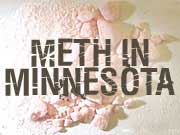Meth labs are hazardous to health
June 14, 2004
 |
| These are a few of the caustic chemicals regularly used to make methamphetamine. Similar products produced by other manufacturers can be used for the same purpose. (Image copyright Publishers Group, www.streetdrugs.org) |
St. Paul, Minn. — Every meth recipe starts with over-the-counter cold medication. The pills are crushed and mixed with other chemicals in the process of cooking meth. One common process follows these steps: Mixing and heating; straining; chemical conversion; extraction; and drying.
Various meth recipes include combinations of volatile organic compounds, also called VOCs, acids, bases, metals, solvents and salts. Making meth with these chemicals can result in explosions, chemical fires, and the release of toxic gases.
Meth cooking also produces solid and liquid wastes that can contaminate a building and its contents, or the groundwater and soil where they are dumped.
Health effects caused by exposure to meth lab chemicals depend on three things: The lab process and the chemicals used; the amount of chemical and length of exposure; and the age and health of the person exposed. Chemicals may enter the body by being breathed, eaten, or absorbed through the skin.
An acute exposure is one that occurs over a relatively short period of time. Acute exposure to meth lab chemicals can cause shortness of breath, cough, chest pain, dizziness, lack of coordination, chemical irritation, or burns to the skin, eyes, nose and mouth. Death could result when exposure to a particularly toxic chemical or the person exposed is particularly vulnerable. Acute exposures can occur in non-drug users during or immediately after "cooking."
Less severe exposures can result in symptoms such as headache, nausea, dizziness and fatigue or lethargy. These symptoms have occured in people exposed to active labs, but also in people -- particularly law enforcement personnel and first responders -- who have entered a drug lab before the site has been cleaned or ventilated. These symptoms usually go away after several hours of exposure to fresh air.
Chronic, or longer term exposure to lab chemicals, may cause both long-term and short-term health effects. Long-term exposures to volatile organic compounds may result in liver and kidney damage, neurological problems, and increased risk of cancer.
Even at low levels, exposures for long periods by people living in a former lab site could result in serious health effects.
COMMON METH LAB CHEMICALS
•Solvents: Include acetone, ether/starter fluid, Freon, Coleman fuel, methanol, toluene, white gas, xylene.
Symptoms/health effects:
Irritation to skin, eyes, nose and throat; headache; dizziness; depression; nausea; vomiting; visual disturbance; cancer.
•Corrosives/irritants: Include anhydrous ammonia, iodine, hydrochloric acid, phosphine, lye, sulfuric acid (drain cleaner).
Symptoms/health effects:
Cough, eye, skin and respiratory irritation; burns and inflammation; gastrointestinal disturbances; thirst; chest tightness; muscle pain; dizziness; convulsions.
•Metals/salts: Include iodine, lithium metal, red phosphorus (from matches), yellow phosphorus, sodium metal.
Symptoms/health effects:
Eye, skin, nose and respiratory irritation; chest tightness; headache; stomach pain; birth defects; jaundice; kidney damage.
(Source: Minnesota Department of Health)
|
News Headlines
|
Related Subjects
|

